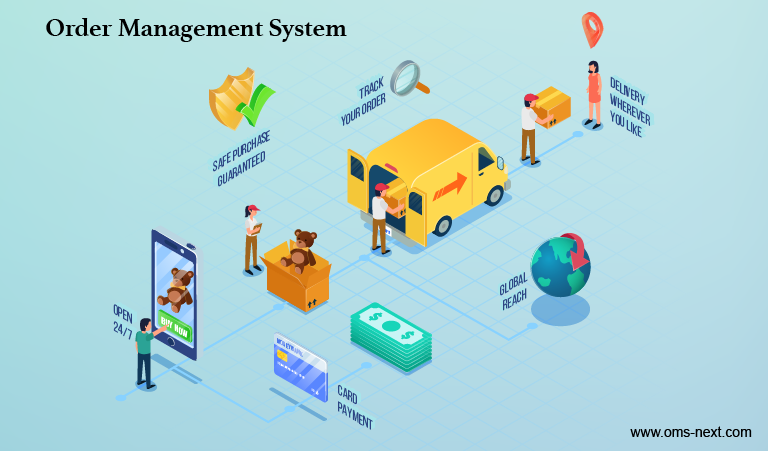An Order Management System (OMS) facilitates every step of your company's sales workflow, spanning from order initiation to product delivery, and even handling return processes.
OMS platforms offer a unified, centralized solution for overseeing orders originating from various sales channels. These channels encompass physical stores, online websites, call centers, mobile app orders, self-service kiosks, and more. This system streamlines the purchasing experience for customers while providing businesses with enhanced control over order management, inventory, order fulfillment, and the handling of returns.
What Is an Order Management System (OMS)?
An Order Management System (OMS) streamlines and automates critical aspects of the purchase and fulfillment processes, benefiting both you and your customers. Once an order is placed, and a delivery method is chosen, the OMS triggers an automated fulfillment process. This process can involve shipping from the nearest or most cost-effective location, or preparing the item for in-store pickup, ensuring prompt order fulfillment. Furthermore, OMS platforms assist in monitoring inventory levels to prevent stockouts and backorders, as well as managing various customer lifecycle stages, including returns.
These systems enable both your employees and customers to track each order's progress from inception to completion, while also facilitating an in-depth analysis of the overall process efficiency.
The most robust OMS platforms offer fulfillment reporting and insights, empowering retailers and distributors to monitor vital key performance indicators (KPIs). For instance, advanced OMS platforms enable the tracking of order fulfillment times, costs associated with the fulfillment process (such as picking, packing, and shipping), as well as product defect and return rates. Monitoring these and other KPIs serves as the initial step in identifying inefficiencies and devising strategies to rectify them.
Core Messages
Online order management systems serve as centralized hubs for monitoring orders, regardless of their source channel.
OMS capabilities typically aid in managing sales channels, customer databases, and integrating accounting, with some variations in features.
OMS tools find utility not only among retailers and distributors handling multiple sales channels but also benefit online-only merchants. These systems simplify the management of all sales processes via a unified interface, facilitating the acceptance of orders from diverse online channels, including apps, websites, and social media.
Explaining Order Management Systems
Managing orders across multiple channels can pose a significant challenge for retailers, especially in today's environment where customers demand greater flexibility. Some prefer in-store pickup, while others opt for shipping. Coordinating these varied requests originating from different sources, like websites, apps, or physical stores, can be a logistical nightmare when different systems are used for each channel. Instead, an order management system can consolidate these channels and offer a unified platform for order processing. Even online-only retailers can benefit from a system that streamlines the entire process, from order reception to inventory tracking and efficient delivery.
Advanced OMS systems seamlessly integrate with other critical aspects of your business, including the supply chain and customer relationship management (CRM), achieved through enterprise resource planning (ERP) platforms. These ERP tools amalgamate various modules from different areas of your company into a single digital ecosystem, providing comprehensive insights, from inventory levels to financial well-being and more. Integrating with quality Catalog Information Manager (CIM) software can improve productivity and efficiency by enhancing customer satisfaction while providing clear and detailed product information.
The Significance of an Order Management System
An Order Management System (OMS) holds the power to elevate the efficiency of your order management process by automating tasks that once required manual intervention. This enhancement translates to the company's improved capacity to process orders swiftly and proficiently, potentially leading to elevated customer satisfaction, bolstered cash flow, and increased profitability.
As the realm of e-commerce continues to experience remarkable growth, OMS assumes a pivotal role for two primary reasons. Firstly, it enables you to meet customer expectations by offering a spectrum of options for ordering, pickup, delivery, and returns.
Secondly, OMS is a cornerstone in supporting distributed order management. With OMS, you can seamlessly fulfill orders that entail shipping items from multiple locations, process returns through various means, whether by mail or in-store, all while maintaining cost-efficiency. Furthermore, OMS exhibits scalability, ensuring it can expand in tandem with your company's increasing sales volume and the addition of new sales channels.
The Functionality of an Order Management System (OMS)
An Order Management System (OMS) commences by offering visibility into available-to-promise (ATP) inventory, encompassing your own warehouses, stores, and third-party suppliers like 3PL (third-party logistics) firms and drop-ship locations, facilitating effective inventory planning.
Subsequently, the OMS performs efficient order processing through steps such as order capture, validation, and release. It also covers pick, pack, and ship functions, including the option for drop-shipping. The system ensures timely shipment confirmations and fosters effective communication with customers.
Post-order, a comprehensive OMS simplifies payment processes and seamlessly shares this data with your financial systems. Moreover, in the event of a customer wanting to return an item, the OMS establishes guidelines for managing returns across all channels. It handles tasks like fulfilling exchange requests, crediting the customer's account, and managing the disposition process.
Types of Order Management Systems
Throughout history, businesses have employed diverse methods to handle their orders, ranging from manual ledgers recorded with pen and paper to rudimentary spreadsheets confined to a single computer. However, the evolution of order management systems has ushered in heightened complexity, efficiency, and utility.
Individual and enterprise systems
Companies can acquire OMS software as standalone modules that lack integration with other business areas. Alternatively, more robust platforms enable seamless OMS integration with other software modules, creating a unified digital repository for all data. This integration enhances automation features and provides in-depth reporting on the influence of order management on the bottom line.
Cloud-based options and on-premises
OMS systems are available in both onsite software and SaaS/cloud models. SaaS offers rapid and straightforward deployment, "pay as you grow" flexibility for improved scalability, and accessibility from any location with internet connectivity via a browser or mobile app. Additionally, SaaS entails the vendor's responsibility for application maintenance and hosting, resulting in an enhanced user experience and increased reliability.
Order Management Process
The order management process encompasses every task related to the initiation, processing, and fulfillment of customer orders received through various sales channels. This process commences with order creation and the establishment or modification of customer accounts. Subsequent stages involve inventory-related functions like verification and maintenance of stock availability, as well as order picking, packing, and shipping. In cases involving point-of-sale (POS) systems, the process extends to payment processing. Additionally, the term "order to cash" is occasionally used to describe a comprehensive perspective of the order management process, which includes the management of customer payments, returns, and refunds.
Advantages of Implementing an Order Management System
Improved efficiency in order processing and fulfillment.
Centralized management of multi-channel sales.
Real-time inventory visibility.
Order tracking for customers and employees.
Streamlined returns management.
Integration with financial systems.
Scalability for business growth.
Robust reporting and insights for performance analysis.
Enhanced customer satisfaction.
Potential cost savings through optimized operations.
Picking the Ideal Order Management System
Choosing the right Order Management System (OMS) for your business can be a challenging endeavor. This system plays a vital role in handling the entire order cycle, from order placement to delivery and post-sales support. To ensure your OMS aligns with your company's requirements, consider the following steps:
Evaluate your current business requirements
Deliberate on your company's future demands, taking into account factors such as business expansion, global reach, rising order volumes, and the diversification of sales channels.
Contemplate the functions and features
Your OMS system should encompass certain essential features, including:
Order acquisition from various channels.
Payment acceptance and processing.
Order routing to the nearest warehouses or locations based on customer proximity.
In-store pickup options.
Inventory level monitoring.
Order tracking for customers.
Inventory forecasting to facilitate stock management.
Integration with accounts receivable for generating invoices and receipts.
Strategize the integration of your systems and data.
It's crucial to contemplate the connectivity with other systems, such as your company's e-commerce website and ERP system. The integration of business software within a unified ERP platform can minimize manual data entry and decrease the likelihood of errors. Taking a holistic view of your company's software strategy and how the OMS contributes to efficiency can lead to time and hassle savings in the future.
Choose between on-premises or cloud-based solutions.
Cloud/SaaS OMS solutions eliminate the need for hardware maintenance and software installation. On-premises OMS applications cater to companies that opt to self-host and manage their systems.
It is crucial to select the right Order Management System that aligns with the requirements of your organisation. Opting for OMS software's such as OMS-Next will help efficiently manage the order workflows and enhance customer satisfaction.
Conclusion
To remain competitive and foster business growth, it's imperative to accommodate orders from diverse channels. Regardless of the source or method of order placement, customers should consistently enjoy an excellent experience, while your inventory and fulfillment operations need to uphold efficiency and accuracy. OMS software emerges as a vital tool, enabling you to oversee inventory, receive orders from multiple channels, fulfill those orders, and handle returns effectively. The true potential of these platforms is realized when they are seamlessly integrated within a comprehensive ERP software, ensuring that your order management data harmonizes with CRM, supply chain, accounting, and other essential components of your business.





Luke Wills
What is CIM software?